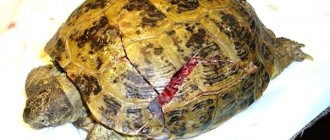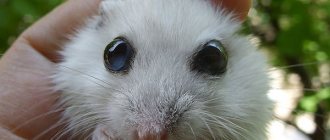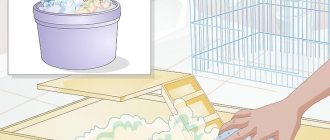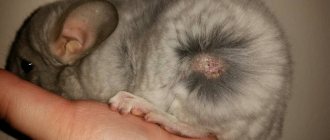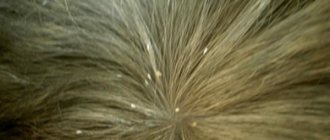- home
- Chinchilla
- Health
04/14/2019 Eye diseases are not considered common diseases in chinchillas. Nevertheless, it still happens to notice pus in the eyes of your beloved pet. This phenomenon can only mean one thing - there is an infection. What to do?
Chinchillas have a strong immune system, so eye inflammation requires immediate action. You should begin as soon as possible to find out the cause of the disease, its elimination and treatment.
Causes of purulent discharge from the eyes
The most common cause of purulent discharge is conjunctivitis. This is one of the most common eye diseases that can affect not only chinchillas, but also pets in general. During this disease, inflammation of the conjunctiva (mucous membrane of the eyes) occurs, symptomatically this is manifested by swelling of the mucous membrane, lacrimation, souring and suppuration.
In most cases, conjunctivitis occurs due to unsanitary conditions for keeping chinchillas (dirty bedding or cage). But there may also be other reasons. For example, purulent discharge from the eyes may be due to a cold or viral infection. In this case, the root cause of poor health should be eliminated. This is especially dangerous, because a cold in a chinchilla can quickly develop into bronchopneumonia. Pay attention to any difficulty breathing or wheezing. Another fairly common culprit of this chinchilla disease is the damaged cornea of the chinchilla's eye. Sometimes dripping eyes can also be a symptom of a very serious condition caused by a malocclusion, hooks, or tooth root growing into the tear duct or eyeball. In this case, surgery is necessary.
Eye diseases and methods of their treatment
Diseases can be identified by visual examination and first aid provided. Immediately you need to rinse the animal’s eyes with warm boiled water using cotton pads or gauze swabs. The corners are softened and dried secretions are removed. The eyelids are carefully spread with your fingers and the mucous membrane is examined so that there are no foreign bodies on it. If any deposits are found, they must be carefully removed. It is allowed to use drops that relieve inflammation as prescribed by a veterinarian.
Video: How to put drops into the eyes of a chinchilla
Conjunctivitis
Conjunctivitis is an inflammation of the mucous membrane of the organs of vision, accompanied by lacrimation and suppuration.
Associated symptoms appear:
- swelling of the eyelids;
- photophobia;
- pus collects in the corners;
- reddened eyelid skin.
Important! After first aid, you must immediately transport the rodent to a veterinary clinic. The specialist will prescribe antibacterial drugs that may solve the problem.
The disease occurs as a result of injuries, falls, or during planting of individuals, exposure to smoke or dust on the mucous membrane, or unsanitary conditions in the cage. Complications may arise as a result of which the eye stops opening altogether. Initially, you need to find the cause - this will help you choose the right course of therapy. If left untreated, ulcers may form on the cornea and the animal may go blind.
Dried purulent accumulations should be removed with a damp cotton swab. Then rinse the eyes with a sterile saline solution of 3% boric acid, a decoction of black tea or chamomile. The cage needs to be cleaned and disinfected.
Cataract
A cataract is a clouding of the lens of the eye that reduces the ability to transmit light. The disease can affect the organ either partially or completely. The bottom line is that a healthy lens is completely transparent. Rays of light are refracted through it and directed to the retina of the organ of vision. When he is struck by cataracts, the pet partially loses his vision and sees the surrounding space as if through streams of water, which is why the name of the disease means “waterfall.”
Important! Cataracts are treated only under the strict supervision of a veterinarian. Unfortunately, with this disease the rodent often loses its vision.
The most common reasons why this disease develops are the following:
- pathologies of the organs of vision;
- impaired metabolism;
- avitaminosis;
- mechanical damage;
- age;
- diabetes;
- heredity and congenital anomaly;
- radiation.
Keratitis
The cornea can become inflamed during mechanical damage, after an animal fight, grains of sand, or during bathing, which provokes keratitis.
Characteristic symptoms:
- unnatural eye color;
- cloudy red shell;
- purulent discharge;
- ulcers.
Find out also how much a chinchilla costs.
For treatment, purchase an ointment that contains antibiotics and fluorescein drops. The consequences of self-medication can cause the progression of a corneal ulcer, so it is necessary to consult a specialist.
Belmo
One of the pathologies of the visual organ, in which persistent clouding of the cornea is observed, is called a cataract.
Appears as a consequence:
- infectious disease;
- injury;
- complications of conjunctivitis.
A white spot appears on the cornea. If you delay in solving the problem, the animal may go blind. The cataract is incurable, so veterinarians have to perform surgery to remove it.
Pay attention to the information on how to properly care for chinchillas at home.
Inflammation and suppuration due to eye injury
In situations where the visual organ is injured, a white spot quickly (literally within a day) appears on the surface of the cornea, which is often confused with a cataract. Such damage occurs due to bruises or the impact of sand crumbs on the mucous membrane of the eye. It is necessary to use Taufon drops or Korneregel ointment.
Complex injuries are accompanied by suppuration and whitening of the iris, as well as inflammation of the eyelids, which causes infection. After preventive measures, you should definitely show the animal to a specialist.
Important! Most products intended for use on people and other pets are not suitable for chinchillas. Rodents have a different sensitivity to medications, so only a veterinarian can determine the correct remedy and dose.
Comprehensive treatment is carried out at home. First, Tetracycline ointment is applied for three days to relieve inflammation. For healing, Korneregel is used for five days. After this, the three-day procedure with Tetracycline is repeated again to treat relapses.
Do I need to rinse my eyes?
Of course it is necessary. Another question - with what?
Quite often, owners use decoctions of medicinal herbs to wash their pets - strong tea, chamomile or calendula decoction. Veterinarians do not advise doing this for a number of reasons: they dry out the mucous membrane, it is impossible to maintain the normal concentration of the solution, such decoctions quickly become unusable, becoming a source of secondary bacterial infection.
To wash the eyes of a chinchilla, it is advisable to use special lotions - Lakrimin, Lakrikan, Ofto-lavas.
In the absence of special means, you can wash your chinchilla’s eyes with simple freshly boiled and cooled water or sterile saline solution.
Conjunctivitis
Conjunctivitis in chinchillas appears as a consequence of injuries (received from falling, landing, playing), being kept in unsanitary conditions, or copious amounts of dirt and dust in the cage. Conjunctivitis sometimes occurs as a complication of viral and infectious diseases of the animal's body.
A similar disease manifests itself:
- Photophobia
- Swelling of the eye and formation of suppuration in the corners
- The eye starts to water
Sometimes chinchillas with conjunctivitis cannot open their eyes. If left untreated, your pet may experience complete loss of vision.
Chinchilla eye drops
For eye inflammation, veterinarians usually prescribe special eye drops “Tsiprovet” or “human” drops “Tsipromed” sold in a regular pharmacy. Their effect is double: broad antibacterial and anti-inflammatory.
You can also use Iris or Tobrex drops. Application: for a diseased eye - 1-2 drops 3 times a day, for a healthy eye (as a mandatory prophylaxis) - 1 drop 1-2 times a day. Duration of treatment – 7 days. Also, in case of emergency, you can use 20% sodium sulfacyl solution, also known as Albucid or Levomycetin. However, remember that these drops cause a burning sensation. In addition, they only have an antibacterial effect.
In case of injury to the eyeball, it is recommended to use drops with taurine - this is a drug that accelerates tissue regeneration. Taurine-based drops – Taufon.
It is extremely important to properly store the opened bottle. Typically, the validity period of the drops after opening the bottle is 7 days. Store opened medicine in the refrigerator. Avoid touching the tip of the dropper - this will significantly reduce the shelf life of the medicine. Before using drops from the refrigerator, warm the bottle in your hand.
Diseases manifested by eye symptoms
Inflammation of the organs of vision in a rodent also signals infections and viral diseases. These include:
- Lichen (trichophytia, microsporia). The disease is contagious to humans. The pet's skin becomes covered with pathogenic fungi, hair begins to fall out on the limbs, around the nose and eyelids. Areas without hair of a clear round shape appear on the skin, which peel off. The examination should be carried out by a doctor using skin scraping. During treatment, be sure to take antifungal agents.
- Diseases of dentistry. Your pet may experience pathological ingrowth of teeth into soft tissue. Elongated roots affect the sinuses and eyes. As a result, discharge from the organs of vision, salivation occurs, and the rodent refuses food. The disease also occurs when the oral cavity is injured or due to an incorrect diet or genetic pathologies. They are treated under anesthesia in a veterinary clinic.
- Tick. Affects animals in rare cases. Infection can occur through food, human hands or litter. The rodent itches more often than usual and tears out the fur around the eyelids and ears, and the fur falls off on the neck and red wounds appear. Veterinarians prescribe insecticidal sprays that are used to treat the pet.
- Cold. When the conditions of detention are violated, the pet can simply catch a cold. There is swelling of the eyelids, runny nose, severe lacrimation, sneezing, rapid breathing, fever, and wheezing. They are treated under the supervision of a specialist.
- Allergy. The reaction may occur to food, cage fillers, or indoor plants. Accompanied by sneezing, mucus discharge from the eye sockets, body itching and the appearance of baldness. It is necessary to eliminate the allergen and conduct a course of therapy with antihistamines.
If you find any unnatural discharge from the organs of vision, redness, swollen eyelids, or hair loss, this may be evidence of a serious viral disease.
Did you know? Chinchillas do not have a specific odor because they do not have sweat glands. Because of this, the animals quickly get wet in the water and cannot stay on its surface.
Treatment of vision problems in chinchillas
Most vision problems require special eye medications, but sometimes surgery may be necessary. Treatment will vary depending on the type of vision problem and its severity.
Corneal ulcers are usually treated with special eye ointments from your veterinarian. Some of these ointments are antibiotics, and some are made specifically to treat ulcers. If the ulcer is really bad or hasn't healed after taking certain medications, your veterinarian may take some of your chinchilla's blood, centrifuge it to separate it into different parts, and use a serum that comes in the form of eye drops to help the ulcer heal. If the ulcer still hasn't healed after all this, a procedure called mesh keratotomy may be needed to stimulate healing. This procedure is done under anesthesia and basically draws a tic-tac-toe on the cornea itself with a sharp object, such as a needle, to encourage the body to heal a bunch of little squares instead of one big ulcer.
If your chinchilla has an eye infection, eye ointments or drops will also be used, but other tests may be needed if these medications do not work. This test is called a culture and uses a cotton swab to collect debris from the eye to see what type of bacteria or fungus is growing there. The results will allow your veterinarian to determine the right treatment for your chinchilla.
Overgrown teeth and tumors that affect the eyes usually require surgery to treat the problem. Tumors, unfortunately, cannot be completely removed, but teeth can be removed. Medicines are also often used to treat a variety of symptoms, including pain, pressure and infections.
Red spot on the white of a child's eye
Sometimes the small blood vessels in the whites of the eyes become damaged and cause one or more red spots to appear.
Note! This is called subconjunctival hemorrhage. Blood vessels can “burst” when sneezing, coughing, or muscle tension, but sometimes it is impossible to determine a specific cause.
Subconjunctival hemorrhage is not a serious problem if vision is not impaired, there is no pain in the eye , and the bleeding does not cover most of the whites or extend into the iris.
Preventive measures
Keep in mind! If anyone in your family has infectious conjunctivitis, it is important to take precautions to avoid infecting healthy family members:
- Wash your hands often with soap . Especially if you touched the victim's eye.
- Do not use the same eye drop bottle dispenser for infected and non-infected eyes (even for the same person).
- Use individual towels , blankets and pillowcases.
- If your child visits the pool, be sure to wear swimming goggles. They will protect against contact with chemicals and microorganisms in the water.
Treatment
At a veterinarian's appointment
The most accessible and harmless first aid method is rubbing the eyes with tincture of calendula or chamomile.
But this is not enough, and the veterinarian will tell you what else is needed for a complete recovery.
For mechanical damage to the eye shell, various steroid eye ointments will help.
But you can only purchase them after consulting a veterinarian, who can also teach you how to do this wiping yourself.
To make a correct diagnosis, it is necessary to analyze other painful symptoms and changes in the behavior of the chinchilla. And only a doctor can prescribe the correct treatment with medications, which include not only ointments and drops, but possibly antibiotics.
From him you can learn that the animal does not receive enough vitamins and needs proper nutrition. The veterinarian will also advise you on what this diet should consist of.
Chinchillas have good resistance to various diseases. Animal owners need to pay attention to:
- timely cleaning of the cage
- temperature regime for keeping the animal
- proper nutrition
Hair ring
Hair ring is a disease that only affects males. It can appear in males of any age. The disease is quite dangerous and can lead to death, since the hair ring makes it difficult to urinate, the penis swells and is not completely retracted, and the risk of dangerous infections increases.
By the following signs you can easily understand that your pet has developed a hair ring:
- The animal has lost its appetite
- Chinchilla doesn't pee
- Chinchilla is lethargic,
- The head of the penis is constantly visible,
- The penis turned blue.
To remove the hair ring, the animal’s reproductive organ is lubricated with Vaseline oil and the ring is carefully pulled off. If it formed a long time ago and has dried up, then you should use nail scissors - they make a neat cut and remove the hair ring.
Cough in rodents
Coughing in rodents can also be caused by various causes. They are presented:
- allergic reaction;
- heart failure. In addition to coughing, it is accompanied by wheezing and shortness of breath;
- tracheitis, pneumonia, bronchitis;
- foreign body in the larynx. The animal gags and attempts to cough up. In this case, you need to try to remove the stuck object yourself by turning the chinchilla upside down or take it to a doctor.
"Important! If suspicious symptoms appear, the owner needs to understand its causes, and for a more thorough diagnosis, it is better to show the rodent to a veterinarian.”
Cataract
One of the eye diseases common to both humans and animals is cataracts. A cataract is a clouding of the lens of the eye and a decrease in its ability to transmit light. The name “cataract” itself translates as “waterfall”. Even the ancients noted that with the development of cataracts, a person begins to see as if through water falling from above. Unfortunately, the causes of the development of this disease have not been studied even in humans, not to mention animals. One thing is certain - heredity plays a significant role in the occurrence of cataracts. You won’t be able to cope with cataracts in an animal yourself; you need timely and qualified help from a specialist.
In this regard, when purchasing a pet, be sure to inquire about the health of its parents; it is better if you can see the pet’s mother and father yourself. Individuals with cataracts are removed from reproduction.


